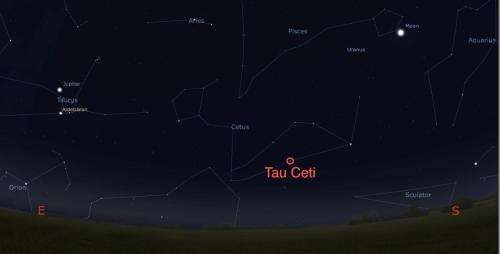"I'm on top of the world,
looking down on creation
and the only explanation I can find is..."
THE SOUTHWORTH PLANETARIUM
207-780-4249 www.usm.maine.edu/planet
70 Falmouth Street Portland, Maine 04103
43.6667° N 70.2667° W
Altitude: 10 feet below sea level
Founded January 1970
Julian date: 2458762.5
2019-2020: XXV
THE DAILY ASTRONOMER
Monday, October 7, 2019
Monday, October 7, 2019
Tau Ceti is No Sibling

Tau Ceti: at a distance of 12 light years, Tau Ceti is the closest single
Sun-like star to the Sun. A Sun-like star is chemically similar to the Sun. As it is so close and so Sun-like, could it be one of Sol's long lost siblings?
Excellent question!
That was our initial response to a query sent after we posted Friday's quiz. This time, we're delighted to write, the quiz wasn't sullied by a silly error, but instead, elicited a brilliant question. If we engage the mind's inexplicable ability to recall the irretrievable past, we remember that in Friday's quiz we mentioned that Tau Ceti was the closest Sun-like star to the solar system. At a distance of only twelve light years, Tau Ceti is certainly just an asteroid's toss away from Sol. (Granted, the Voyager I craft would require tens of thousands of years to traverse that distance, but here we're referring to stellar standards.) By Sun-like, we mean that Tau Ceti is spectrally (and therefore chemically) similar to our own parent star. Even though Tau Ceti is about 78% smaller, we can still consider it to be very much like the Sun. The answer to that question prompted the following question:
"You mentioned that astronomers have found two stars that were the Sun's siblings. They know of them because of their chemistries. If Tau Ceti is about the same chemically and so close, why isn't it one of the Sun's sisters too?"
A.S., Norridgewock, Maine
Greetings.
We'll answer the question with a simple statement and then we'll devote the remainder of the response by justifying the statement.
Tau Ceti is not the Sun's siblings because it is almost a billion years older than the Sun and therefore formed much earlier.
As the Sun and its companions formed over a period of approximately 10 million years, Tau Ceti couldn't have possibly have arisen from the same cloud. So, how can astronomers possibly know the star's age?
To answer this question, we first much discuss "metallicity," the relative abundance of "metals" within stars. In this context, 'metals' refers to any elements heavier than helium. The interstellar medium (ISM) and the gaseous clouds formed out of it consists of 70% hydrogen and 28% helium, with trace amounts of metals. The metallicity of a given region of space changes with time due to supernova explosions (the explosions of highly massive stars at the end of their life cycles) that expel heavy element material into space. The incorporation of these remnants into a specific cloud or ISM region increases its metallicity. As the Universe ages, the ISM becomes more metal-rich as more supernova explosions occur.
The actual measurement of metallicity involves the ratio of Iron to Hydrogen. Spectral analysis of Tau Ceti's light reveals the ratio in Tau Ceti to be about a third that of the Sun. This difference suggests that Tau Ceti is significantly older as the material from which it formed contained fewer "metals." Tau Ceti's estimated age is approximately six billion years: too old for sisterhood.
Tau Ceti is spectrally similar. Its spectral type is G, just like the Sun's. * However, it is not chemically similar enough to the Sun indicate that it is the Sun's sibling.
*A "G" type star has an effective temperature between 5,200 - 6,000 K with stellar masses comparable to that of the Sun.
TO SUBSCRIBE OR UNSUBSCRIBE FROM THE "DAILY ASTRONOMER" LIST-SERVE: